16.4E : Exercices pour la section 16.4
- Page ID
- 197906
Pour les exercices suivants, évaluez les intégrales linéaires en appliquant le théorème de Green.
1. \(\displaystyle \int_C 2xy\,dx+(x+y)\,dy\), où\(C\) est la trajectoire\((0, 0)\) allant de et le\((1, 1)\) long du graphe\(y=x^3\) et de\((1, 1)\) à\((0, 0)\) le long du graphe d'\(y=x\)orienté dans le sens antihoraire
2. \(\displaystyle \int_C 2xy\,dx+(x+y)\,dy\), où\(C\) est la limite de la région située entre les graphes de\(y=0\) et\(y=4−x^2\) orientée dans le sens antihoraire
- Réponse
- \(\displaystyle \int_C2xy\,dx+(x+y)\,dy=\frac{32}{3}\)unités de travail
3. \(\displaystyle \int_C 2\arctan\left(\frac{y}{x}\right)\,dx+\ln(x^2+y^2)\,dy\), où\(C\) est défini par\(x=4+2\cos θ,\;y=4\sin θ\) orienté dans le sens antihoraire
4. \(\displaystyle \int_C \sin x\cos y\,dx+(xy+\cos x\sin y)\,dy\), où\(C\) est la limite de la région située entre les graphes de\(y=x\) et\(y=\sqrt{x}\) orientée dans le sens antihoraire
- Réponse
- \(\displaystyle \int_C\sin x\cos y\,dx+(xy+\cos x\sin y)\,dy=\frac{1}{12}\)unités de travail
5. \(\displaystyle \int_C xy\,dx+(x+y)\,dy\), où\(C\) est la limite de la région située entre les graphes de\(x^2+y^2=1\) et\(x^2+y^2=9\) orientée dans le sens antihoraire
6. \(\displaystyle ∮_C (−y\,dx+x\,dy)\), où\(C\) se compose d'un segment\(C_1\) de ligne allant de\((−1,0)\) à\((1, 0)\), suivi de l'arc semi-circulaire\(C_2\) allant de l'\((1, 0)\)arrière vers\((-1, 0)\)
- Réponse
- \(\displaystyle ∮_C (−y\,\,dx+x\,\,dy)=π\)unités de travail
Pour les exercices suivants, utilisez le théorème de Green.
7. \(C\)Soit la courbe composée de segments de ligne allant de\((0, 0)\) à\((1, 1)\) à\((0, 1)\) et retour à\((0, 0)\). Trouvez la valeur de\(\displaystyle \int_C xy\,dx+\sqrt{y^2+1}\,dy\).
8. Évaluez l'intégrale de la ligne\(\displaystyle \int_C xe^{−2x}\,dx+(x^4+2x^2y^2)\,dy\), où\(C\) se trouve la limite de la région entre les cercles\(x^2+y^2=1\) et\(x^2+y^2=4\), et est une courbe orientée positivement.
- Réponse
- \(\displaystyle \int_C xe^{−2x}\,dx+(x^4+2x^2y^2)\,dy=0\)unités de travail
9. Déterminez la circulation du champ dans le sens antihoraire\(\vecs F(x,y)=xy\,\mathbf{\hat i}+y^2\,\mathbf{\hat j}\) autour et au-dessus de la limite de la région délimitée par des courbes\(y=x^2\) et\(y=x\) dans le premier quadrant et orientée dans le sens antihoraire.
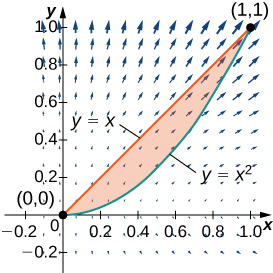
10. Évaluez\(\displaystyle ∮_C y^3\,dx−x^3y^2\,dy\), où\(C\) se trouve le cercle de rayon orienté positivement\(2\) centré sur l'origine.
- Réponse
- \(\displaystyle ∮_C y^3\,dx−x^3y^2\,dy=−20π\)unités de travail
11. Evaluer\(\displaystyle ∮_C y^3\,dx−x^3\,dy\), où\(C\) inclut les deux cercles de rayon\(2\) et de rayon\(1\) centrés sur l'origine, tous deux avec une orientation positive.
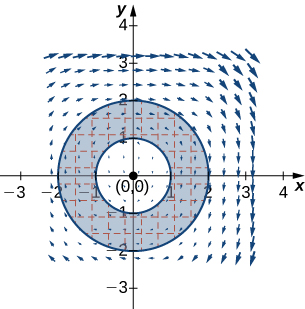
12. Calculez\(\displaystyle ∮_C −x^2y\,dx+xy^2\,dy\), où\(C\) est un cercle de rayon\(2\) centré à l'origine et orienté dans le sens antihoraire.
- Réponse
- \(\displaystyle ∮_C −x^2y\,dx+xy^2\,dy=8π\)unités de travail
13. Calculez l'intégrale\(\displaystyle ∮_C 2[y+x\sin(y)]\,dx+[x^2\cos(y)−3y^2]\,dy\) le long\(C\) d'un triangle avec des sommets\((0, 0), \,(1, 0)\) et\((1, 1)\), dans le sens antihoraire, en utilisant le théorème de Green.
14. Évaluez l'intégrale\(\displaystyle ∮_C (x^2+y^2)\,dx+2xy\,dy\), où\(C\) est la courbe qui suit la parabole\(y=x^2\) à partir de\((0,0), \,(2,4),\) puis la droite de\((2, 4)\) à\((2, 0)\) et enfin la droite de\((2, 0)\) à\((0, 0)\).
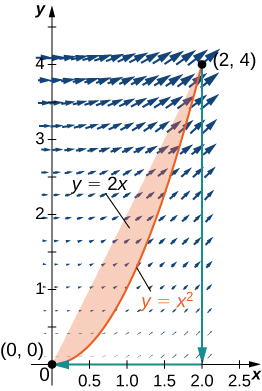
- Réponse
- \(\displaystyle ∮_C (x^2+y^2)\,dx+2xy\,dy=0\)unités de travail
15. Évaluez l'intégrale de la ligne\(\displaystyle ∮_C (y−\sin(y)\cos(y))\,dx+2x\sin^2(y)\,dy\), qui\(C\) est orientée dans le sens antihoraire autour de la région délimitée par\(x=−1, \,x=2, \,y=4−x^2\), et\(y=x−2.\)
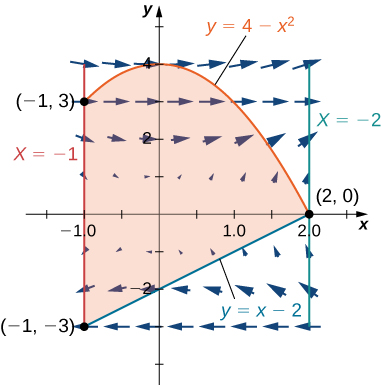
Pour les exercices suivants, utilisez le théorème de Green pour trouver la zone.
16. Détermine l'aire entre l'ellipse\(\frac{x^2}{9}+\frac{y^2}{4}=1\) et le cercle\(x^2+y^2=25\).
- Réponse
- \(A=19π\;\text{units}^2\)
17. Détermine l'aire de la région délimitée par une équation paramétrique
\(\vecs p(θ)=(\cos(θ)−\cos^2(θ))\,\mathbf{\hat i}+(\sin(θ)−\cos(θ)\sin(θ))\,\mathbf{\hat j}\)pour\(0≤θ≤2π.\)
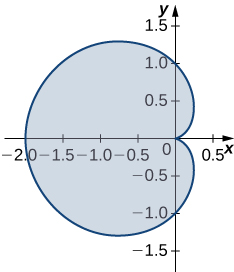
18. Trouvez la zone de la région délimitée par l'hypocycloïde\(\vecs r(t)=\cos^3(t)\,\mathbf{\hat i}+\sin^3(t)\,\mathbf{\hat j}\). La courbe est paramétrée par\(t∈[0,2π].\)
- Réponse
- \(A=\frac{3}{8π}\;\text{units}^2\)
19. Détermine l'aire d'un pentagone avec des sommets\((0,4), \,(4,1), \,(3,0), \,(−1,−1),\) et\((−2,2)\).
20. Utilisez le théorème de Green pour évaluer\(\displaystyle \int_{C^+}(y^2+x^3)\,dx+x^4\,dy\) où\(C^+\) est le périmètre du carré\([0,1]×[0,1]\) orienté dans le sens antihoraire.
- Réponse
- \(\displaystyle \int_{C^+} (y^2+x^3)\,dx+x^4\,dy=0\)
21. Utilisez le théorème de Green pour prouver que l'aire d'un disque avec un rayon\(a\) est\(A=πa^2\;\text{units}^2\).
22. Utilisez le théorème de Green pour déterminer l'aire d'une boucle d'une rose à quatre feuilles\(r=3\sin 2θ\). (Astuce :\(x\,dy−y\,dx=r^2\,dθ\)).
- Réponse
- \(A=\frac{9π}{8}\;\text{units}^2\)
23. Utilisez le théorème de Green pour déterminer l'aire sous une arche de la cycloïde donnée par les équations paramétriques :\(x=t−\sin t,\;y=1−\cos t,\;t≥0.\)
24. Utilisez le théorème de Green pour déterminer l'aire de la région délimitée par la courbe
\(\vecs r(t)=t^2\,\mathbf{\hat i}+\left(\frac{t^3}{3}−t\right)\,\mathbf{\hat j},\)pour\(−\sqrt{3}≤t≤\sqrt{3}\).
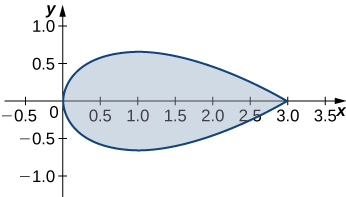
- Réponse
- \(A=\frac{8\sqrt{3}}{5}\;\text{units}^2\)
25. [T] Évaluez le théorème de Green à l'aide d'un système d'algèbre informatique pour évaluer l'intégrale\(\displaystyle \int_C xe^y\,dx+e^x\,dy\), où\(C\) est le cercle donné par\(x^2+y^2=4\) et est orienté dans le sens antihoraire.
26. Évaluez\(\displaystyle \int_C(x^2y−2xy+y^2)\,ds\), où\(C\) se trouve la limite du carré unitaire\(0≤x≤1,\;0≤y≤1\), parcourue dans le sens antihoraire.
- Réponse
- \(\displaystyle \int_C (x^2y−2xy+y^2)\,ds=3\)
27. Évaluez\(\displaystyle \int_C \frac{−(y+2)\,dx+(x−1)\,dy}{(x−1)^2+(y+2)^2}\), où\(C\) se trouve une courbe fermée simple dont l'intérieur ne contient pas de point\((1,−2)\) parcouru dans le sens antihoraire.
28. Évaluez\(\displaystyle \int_C \frac{x\,dx+y\,dy}{x^2+y^2}\), où se\(C\) trouve une courbe fermée simple et lisse, par morceaux, entourant l'origine, parcourue dans le sens antihoraire.
- Réponse
- \(\displaystyle \int_C \frac{x\,dx+y\,dy}{x^2+y^2}=2π\)
Pour les exercices suivants, utilisez le théorème de Green pour calculer le travail effectué par la force\(\vecs F\) sur une particule qui se déplace dans le sens antihoraire sur une trajectoire fermée\(C\).
29. \(\vecs F(x,y)=xy\,\mathbf{\hat i}+(x+y)\,\mathbf{\hat j}, \quad C:x^2+y^2=4\)
30. \(\vecs F(x,y)=(x^{3/2}−3y)\,\mathbf{\hat i}+(6x+5\sqrt{y})\,\mathbf{\hat j}, \quad C\): boundary of a triangle with vertices \((0, 0), \,(5, 0),\) and \((0, 5)\)
- Answer
- \(W=\frac{225}{2}\) units of work
31. Evaluate \(\displaystyle \int_C (2x^3−y^3)\,dx+(x^3+y^3)\,dy\), where \(C\) is a unit circle oriented in the counterclockwise direction.
32. A particle starts at point \((−2,0)\), moves along the \(x\)-axis to \((2, 0)\), and then travels along semicircle \(y=\sqrt{4−x^2}\) to the starting point. Use Green’s theorem to find the work done on this particle by force field \(\vecs F(x,y)=x\,\mathbf{\hat i}+(x^3+3xy^2)\,\mathbf{\hat j}\).
- Answer
- \(W=12π\) units of work
33. David and Sandra are skating on a frictionless pond in the wind. David skates on the inside, going along a circle of radius \(2\) in a counterclockwise direction. Sandra skates once around a circle of radius \(3\), also in the counterclockwise direction. Suppose the force of the wind at point \((x,y)\) is \(\vecs F(x,y)=(x^2y+10y)\,\mathbf{\hat i}+(x^3+2xy^2)\,\mathbf{\hat j}\). Use Green’s theorem to determine who does more work.
34. Use Green’s theorem to find the work done by force field \(\vecs F(x,y)=(3y−4x)\,\mathbf{\hat i}+(4x−y)\,\mathbf{\hat j}\) when an object moves once counterclockwise around ellipse \(4x^2+y^2=4.\)
- Answer
- \(W=2π\) units of work
35. Use Green’s theorem to evaluate line integral \(\displaystyle ∮_C e^{2x}\sin 2y\,dx+e^{2x}\cos 2y\,dy\), where \(C\) is ellipse \(9(x−1)^2+4(y−3)^2=36\) oriented counterclockwise.
36. Evaluate line integral \(\displaystyle ∮_C y^2\,dx+x^2\,dy\), where \(C\) is the boundary of a triangle with vertices \((0,0), \,(1,1)\), and \((1,0)\), with the counterclockwise orientation.
- Answer
- \(\displaystyle ∮_C y^2\,dx+x^2\,dy=\frac{1}{3}\) units of work
37. Use Green’s theorem to evaluate line integral \(\displaystyle \int_C \vecs h·d\vecs r\) if \(\vecs h(x,y)=e^y\,\mathbf{\hat i}−\sin πx\,\mathbf{\hat j}\), where \(C\) is a triangle with vertices \((1, 0), \,(0, 1),\) and \((−1,0),\) traversed counterclockwise.
38. Use Green’s theorem to evaluate line integral \(\displaystyle \int_C\sqrt{1+x^3}\,dx+2xy\,dy\) where \(C\) is a triangle with vertices \((0, 0), \,(1, 0),\) and \((1, 3)\) oriented clockwise.
- Answer
- \(\displaystyle \int_C \sqrt{1+x^3}\,dx+2xy\,dy=3\) units of work
39. Use Green’s theorem to evaluate line integral \(\displaystyle \int_C x^2y\,dx−xy^2\,dy\) where \(C\) is a circle \(x^2+y^2=4\) oriented counterclockwise.
40. Use Green’s theorem to evaluate line integral \(\displaystyle \int_C \left(3y−e^{\sin x}\right)\,dx+\left(7x+\sqrt{y^4+1}\right)\,dy\) where \(C\) is circle \(x^2+y^2=9\) oriented in the counterclockwise direction.
- Answer
- \(\displaystyle \int_C \left(3y−e^{\sin x}\right)\,dx+\left(7x+\sqrt{y^4+1}\right)\,dy=36π\) units of work
41. Use Green’s theorem to evaluate line integral \(\displaystyle \int_C (3x−5y)\,dx+(x−6y)\,dy\), where \(C\) is ellipse \(\frac{x^2}{4}+y^2=1\) and is oriented in the counterclockwise direction.
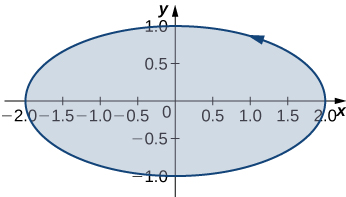
42. Let \(C\) be a triangular closed curve from \((0, 0)\) to \((1, 0)\) to \((1, 1)\) and finally back to \((0, 0).\) Let \(\vecs F(x,y)=4y\,\mathbf{\hat i}+6x^2\,\mathbf{\hat j}.\) Use Green’s theorem to evaluate \(\displaystyle ∮_C\vecs F·d\vecs r.\)
- Answer
- \(\displaystyle ∮_C\vecs F·d\vecs r=2\) units of work
43. Use Green’s theorem to evaluate line integral \(\displaystyle ∮_C y\,dx−x\,dy\), where \(C\) is circle \(x^2+y^2=a^2\) oriented in the clockwise direction.
44. Use Green’s theorem to evaluate line integral \(\displaystyle ∮_C (y+x)\,dx+(x+\sin y)\,dy,\) where \(C\) is any smooth simple closed curve joining the origin to itself oriented in the counterclockwise direction.
- Answer
- \(\displaystyle ∮_C (y+x)\,dx+(x+\sin y)\,dy=0\) units of work
45. Use Green’s theorem to evaluate line integral \(\displaystyle ∮_C \left(y−\ln(x^2+y^2)\right)\,dx+\left(2\arctan \frac{y}{x}\right)\,dy,\) where \(C\) is the positively oriented circle \((x−2)^2+(y−3)^2=1.\)
46. Use Green’s theorem to evaluate \(\displaystyle ∮_C xy\,dx+x^3y^3\,dy,\) where \(C\) is a triangle with vertices \((0, 0), \,(1, 0),\) and \((1, 2)\) with positive orientation.
- Answer
- \(\displaystyle ∮_C xy\,dx+x^3y^3\,dy=2221\) units of work
47. Use Green’s theorem to evaluate line integral \(\displaystyle \int_C \sin y\,dx+x\cos y\,dy,\) where \(C\) is ellipse \(x^2+xy+y^2=1\) oriented in the counterclockwise direction.
48. Let \(\vecs F(x,y)=\left(\cos(x^5)−13y^3\right)\,\mathbf{\hat i}+13x^3\,\mathbf{\hat j}.\) Find the counterclockwise circulation \(\displaystyle ∮_C\vecs F·d\vecs r,\) where \(C\) is a curve consisting of the line segment joining \((−2,0)\) and \((−1,0),\) half circle \(y=\sqrt{1−x^2},\) the line segment joining \((1, 0)\) and \((2, 0),\) and half circle \(y=\sqrt{4−x^2}.\)
- Answer
- \(\displaystyle ∮_C\vecs F·d\vecs r=15π^4\) units of work
49. Use Green’s theorem to evaluate line integral \(\displaystyle ∫_C \sin(x^3)\,dx+2ye^{x^2}\,dy,\) where \(C\) is a triangular closed curve that connects the points \((0, 0), \,(2, 2),\) and \((0, 2)\) counterclockwise.
50. Let \(C\) be the boundary of square \(0≤x≤π,\;0≤y≤π,\) traversed counterclockwise. Use Green’s theorem to find \(\displaystyle ∫_C \sin(x+y)\,dx+\cos(x+y)\,dy.\)
- Answer
- \(\displaystyle \int_C\sin(x+y)\,dx+\cos(x+y)\,dy=4\) units of work
51. Use Green’s theorem to evaluate line integral \(\displaystyle ∫_C \vecs F·d\vecs r,\) where \(\vecs F(x,y)=(y^2−x^2)\,\mathbf{\hat i}+(x^2+y^2)\,\mathbf{\hat j},\) and \(C\) is a triangle bounded by \(y=0,\;x=3,\) and \(y=x,\) oriented counterclockwise.
52. Use Green’s Theorem to evaluate integral \(\displaystyle ∫_C \vecs F·d\vecs r,\) where \(\vecs F(x,y)=(xy^2)\,\mathbf{\hat i}+x\,\mathbf{\hat j},\) and \(C\) is a unit circle oriented in the counterclockwise direction.
- Answer
- \(\displaystyle ∫_C \vecs F·d\vecs r=π\) units of work
53. Use Green’s theorem in a plane to evaluate line integral \(\displaystyle ∮_C (xy+y^2)\,dx+x^2\,dy,\) where \(C\) is a closed curve of a region bounded by \(y=x\) and \(y=x^2\) oriented in the counterclockwise direction.
54. Calculate the outward flux of \(\vecs F(x,y)=−x\,\mathbf{\hat i}+2y\,\mathbf{\hat j}\) over a square with corners \((±1,\,±1),\) where the unit normal is outward pointing and oriented in the counterclockwise direction.
- Answer
- \(\displaystyle ∮_C\vecs F·\vecs N \,ds=4\)
55. [T] Let \(C\) be circle \(x^2+y^2=4\) oriented in the counterclockwise direction. Evaluate \(\displaystyle ∮_C \left[\left(3y−e^{\arctan x})\,dx+(7x+\sqrt{y^4+1}\right)\,dy\right]\) using a computer algebra system.
56. Find the flux of field \(\vecs F(x,y)=−x\,\mathbf{\hat i}+y\,\mathbf{\hat j}\) across \(x^2+y^2=16\) oriented in the counterclockwise direction.
- Answer
- \(\displaystyle ∮_C \vecs F·\vecs N\,ds=32π\)
57. Let \(\vecs F=(y^2−x^2)\,\mathbf{\hat i}+(x^2+y^2)\,\mathbf{\hat j},\) and let \(C\) be a triangle bounded by \(y=0, \,x=3,\) and \(y=x\) oriented in the counterclockwise direction. Find the outward flux of \(\vecs F\) through \(C\).
58. [T] Let \(C\) be unit circle \(x^2+y^2=1\) traversed once counterclockwise. Evaluate \(\displaystyle ∫_C \left[−y^3+\sin(xy)+xy\cos(xy)\right]\,dx+\left[x^3+x^2\cos(xy)\right]\,dy\) by using a computer algebra system.
- Answer
- \(\displaystyle ∫_C \left[−y^3+\sin(xy)+xy\cos(xy)\right]\,dx+\left[x^3+x^2\cos(xy)\right]\,dy=4.7124\) units of work
59. [T] Find the outward flux of vector field \(\vecs F(x,y)=xy^2\,\mathbf{\hat i}+x^2y\,\mathbf{\hat j}\) across the boundary of annulus \(R=\big\{(x,y):1≤x^2+y^2≤4\big\}=\big\{(r,θ):1≤r≤2,\,0≤θ≤2π\big\}\) using a computer algebra system.
60. Consider region \(R\) bounded by parabolas \(y=x^2\) and \(x=y^2.\) Let \(C\) be the boundary of \(R\) oriented counterclockwise. Use Green’s theorem to evaluate \(\displaystyle ∮_C \left(y+e^{\sqrt{x}}\right)\,dx+\left(2x+\cos(y^2)\right)\,dy.\)
- Answer
- \(\displaystyle ∮_C \left(y+e^{\sqrt{x}}\right)\,dx+\left(2x+\cos(y^2)\right)\,dy=13\) units of work


